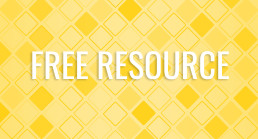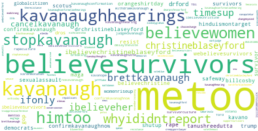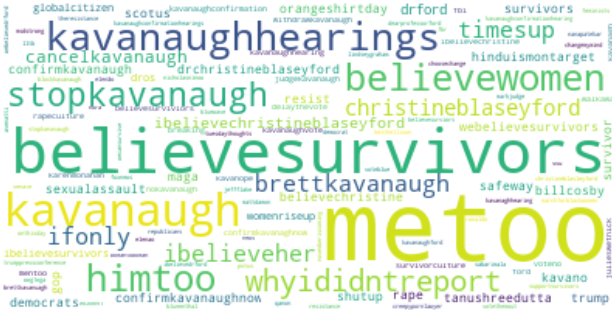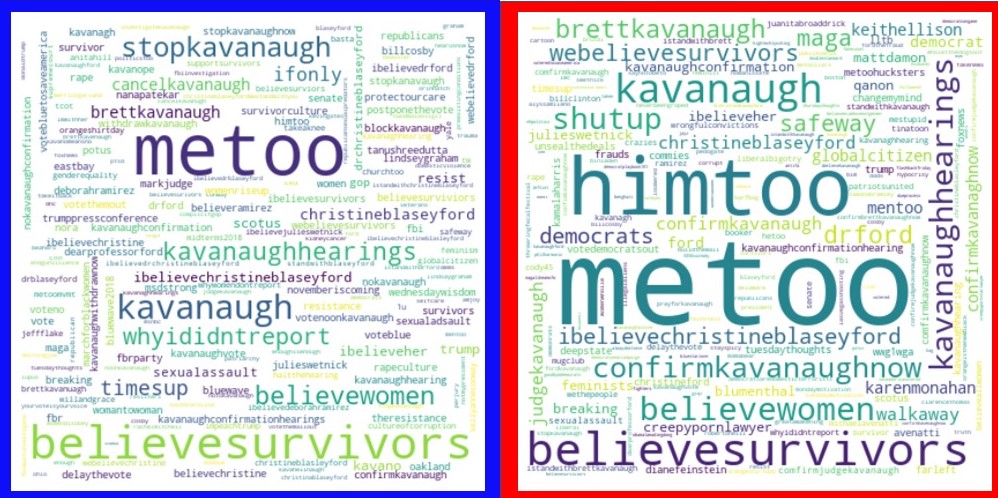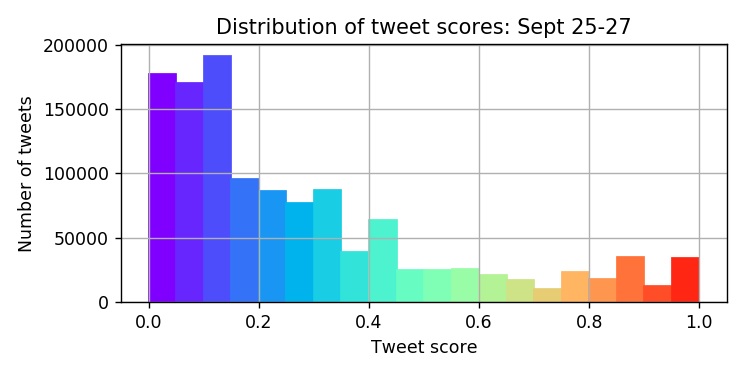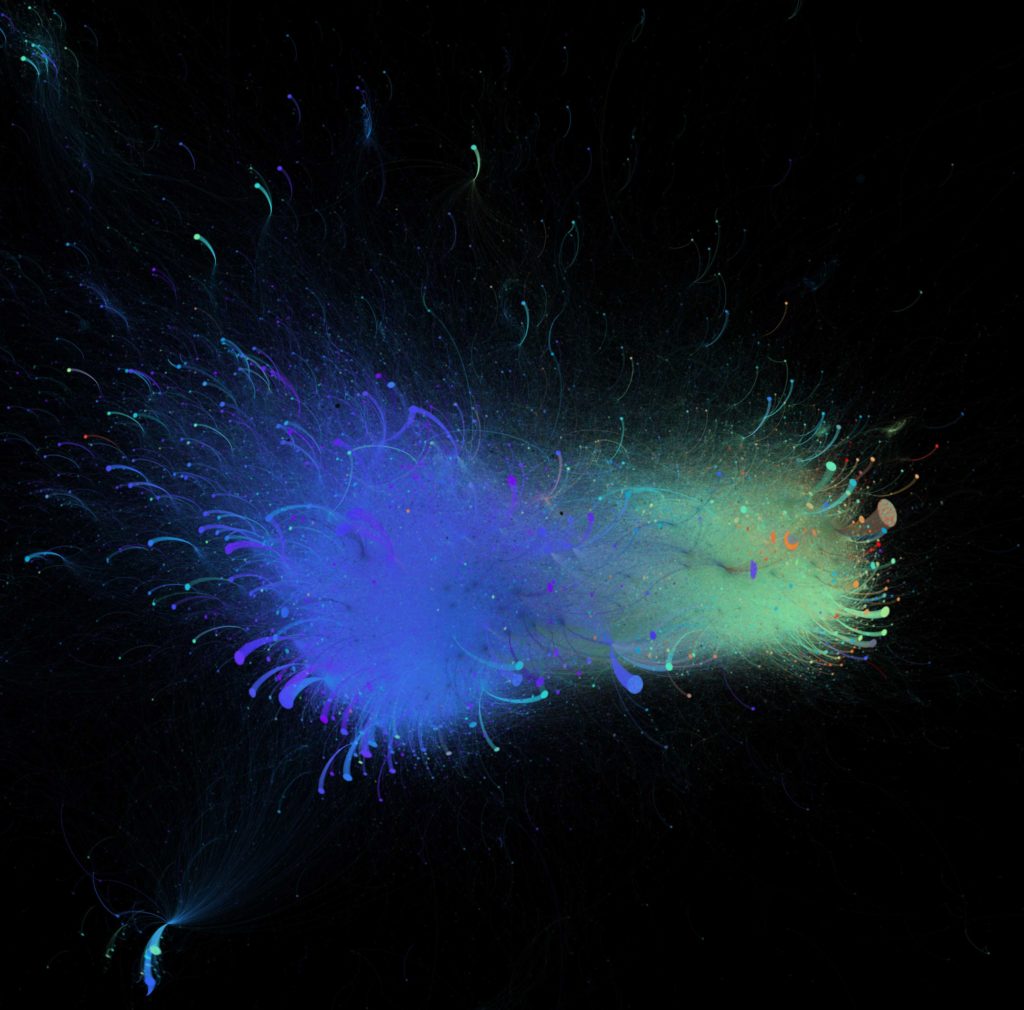Identifying Leverage Points to Focus Action
The idea behind the identification of leverage points is the assumption that working in some areas can be more productive than others. A leverage point is a place where, if people focus their collaborative efforts, they can begin to shift a system because there is a new opportunity emerging for change. This new opportunity might be a new openness and awareness in people (for example, the recent focus on dismantling racism and white supremacy) or change in policy or in the availability of new resources.
Instead of simply working on the most important action, identification of leverage points is helping people look for something that is most likely to succeed, and will build new momentum for change. The opportunity makes it more likely that any action the group does will be successful and make a difference.
Often working in a leverage point will bring together new partners who will have different perspectives on the problem and when the leverage group discusses what to do, they often make breakthroughs in the way they think about the problem or issue.
Another important aspect to leverage points is that they will start shifting the system on several different levels simultaneously. For example, when a group I worked with recently decided to work on dismantling racism and white supremacy, they read the article by Tema Okun, then discussed how they saw examples of white supremacy culture in their own behavior and talked about how they could shift that behavior. They took a network values survey that helped them see their strengths and challenges as a group around interacting in new ways and generated a set of actions to shift as a group. They also talked about how they could bring this awareness back to their organizations and communities.
Some networks do a system mapping activity to identify leverage points but this a process that takes more time. If you are interested in this, you can check out the course on System Mapping offered at no cost by Acumen.
The free resource for this week is Leverage Point Identification Activity which you can find in the Resources section here.
Learning Weavers
What are learning weavers? Why does your network need them?
I’ve often thought that we need to spend much more time and energy making sense of and learning from what we are doing. Along with that, think how much our networks could benefit if they could share the many great ideas and practices that are generated in collaborative projects and help others use those ideas and practices in their efforts.
But it just isn’t happening to the extent that is needed. So what are we missing? What needs to happen to help capture learning and spread it around?
Last week we came up with an idea: can we explicitly build a pool of people who are assigned to network and project sessions and whose job it is to capture the essence of the session and any new ideas or practices that emerge. We could call them learning weavers.
After the session they might snip short videos from session (of course asking permission of the person speaking) where someone is sharing something important and/or innovative and share them with some annotation on the network’s email list or newsletter. They also might write a blog post sharing a particularly interesting approach with the rest of the network. For example, a slide or two used during the session might offer a useful visualization of something that the rest of the network could benefit from. The group might have used an interesting survey, or implemented an activity that could be used in other settings.
For training sessions that would be of interest to many in the network, learning weavers could annotate the resultant video, noting who was saying what at different points in the agenda. (Youtube has a simple way to create something like a table of contents that can take people directly to a specific part of the video.)
They also might periodically interview working groups or project coordinators, or members of a network circle such as communications, to find out what they have been learning and then share with the network.
These learning nuggets could be productized - turned into a module and offered free or for sale in a network store (see our Resources tab on this site for an example of such a store).
[ap_spacing spacing_height="30px"]
What skills would such a person need?
They would definitely need excellent writing skills, a knack for analysis, some video editing skills and maybe some graphics experience.
[ap_spacing spacing_height="30px"]
How much would it cost for a learning weaver pool?
I estimate that you could find excellent weavers for $50-100/hour. Your network might start with a pilot project, bringing on a group of 2 or 3 learning weavers and using them for selected sessions where you know innovation is likely to happen. You might need to invest in their learning about networks so they know what to look for, and it would be good for the group to come together after a month or two of work and analyze how it went and what needs to be changed. Such a pilot might cost only a few thousand dollars.
Seems like a small price to pay to be able to capture and share all the innovation and learning that is happening in our networks. I’d be glad to work with anyone to help set something like this up!
Please comment below and let me know what you think of this idea.
For the Sake of Change: Consider the Vastness Not Entered
Two pieces of art have been working me over lately. And I have been sharing them with others in different social justice spaces. One is a poem by Simon J. Ortiz, “Culture and the Universe,” shared with me by Mariana Velez Laris of The Nature Conservancy’s Indigenous Peoples and Local Communities Network. The second is the book Race and the Cosmos by Barbara A. Holmes, that I know through the good people at the Center for Action and Contemplation. Both works invite the reader to stretch and open in different ways for the sake of change and … evolution.
Here is Ortiz’s poem:
Two nights ago in the canyon darkness,
only the half-moon and stars,only mere men.
Prayer, faith, love,
existence.
We are measured
by vastness beyond ourselves.
Dark is light.
Stone is rising.
I don’t know
if humankind understands
culture: the act
of being human
is not easy knowledge.
With painted wooden sticks
and feathers, we journey
into the canyon toward stone,
a massive presence
in midwinter.
We stop.
Lean into me.
The universe
sings in quiet meditation.
We are wordless:
I am in you.
Without knowing why
culture needs our knowledge,
we are one self in the canyon.
And the stone wall
I lean upon spins me
wordless and silent
to the reach of stars
and to the heavens within.
It’s not humankind after all
nor is it culture
that limits us.
It is the vastness
we do not enter.
It is the stars
we do not let own us.
Very recently I brought this poem to a group of community organizers from a state-wide political action network, and after hearing it, many said they were really touched by this notion of there being a vastness they do not enter, and are therefore limited by. References were made to systems of oppression, to antagonism, to fear and lack of love. There is so much more to this world and by extension to ourselves that we do not tap into that keeps us repeating patterns of behavior and systems that do not serve our fuller humanity.
“We use language not so much to convey factual information as to construct worlds.”
– Barbara A. Holmes

Holmes’ book extends this same theme of vastness, drawing from the fields of quantum physics, cosmology and ethics as a way of inviting a broader perspective and creating new language and thinking that points in the direction of a world where everyone belongs. She writes, for example, about “dark matter” and “dark energy,” which is pervasive and cohesive in the universe, the essentially creative energy that holds things together. Considering this profound and primordial force, Holmes says, we can only wonder at and celebrate “darkness,” not fear or denigrate it.
Holmes also invites us to consider that physics and cosmology point to the fundamental nature of reality as existing in relationship and interdependence and that systems of oppression go against the grain of the unfolding cosmos. She writes, “Our desire for justice is deeply rooted in systems that are holistic and relational. We have not forced, created, or dreamed this shared destiny; it seems to be the way of the universe.”
In times of breakdown and cynicism, both Ortiz and Holmes tell us that creativity and hope are to be found by looking more deeply into nature and more widely into the heavens to re-member who we are and that there are so many more possibilities than what we have created and perpetuate.
What vastness have you not yet entered, what wonders in our world and beyond have you not allowed to grab hold of you that might liberate and generate new possibilities in your change agency?
Originally published at Interaction Institute for Social Change on March 6, 2019
Header Image by Adam Meek, shared under provision of Creative Commons Attribution license 2.0.
Awareness Activities
A lot of research has been conducted lately to identify how awareness or mindfulness operates in our brain, the benefits of this mental state, and how we can spend more time in a mindful state. This research is of great value to Network Weavers. Two excellent books on the topic are Your Brain At Work by David Rock and Mindsight by Daniel Siegel. Also, consider exploring Researching Your Own Practice: The Discipline of Noticing.
Mindfulness occurs when we are able to step back from our present situation and reflect on what is occurring in a detached fashion. This state is extremely helpful to Network Weavers because it enables us to temporarily suspend our positions, emotions, or arguments and get a bigger and more nuanced sense of what is occurring. This opens the opportunity to act in new, refreshing ways: to appreciate the other, to listen more deeply, to notice potential.
The Awareness Activities in this handout can help us become more aware of what is happening around us.
[ap_spacing spacing_height="30px"]
Network Weaver Free Resources Package
Each week, we add a new free item to our store.

This week we are offering: Network Weaver FREE RESOURCES PACKAGE.
ALL of the free resources currently available at the Network Weaver Resource Page in one complete downloadable file.
Conversations in Networks
In early September I started collecting #MeToo tweets and stumbled into a big-data look at #MeToo and the Kavanaugh confirmation. As I posted previously, the Twitter network is radically split into red and blue factions. (FiveThirtyEight subsequently wrote about this divide, based not on Twitter but on polls, and arrived at the same conclusion.) Now I want to post an update on this project, which is more than ever a work in progress. I’m especially wanting input from #MeToo movement organizers, who hopefully have real questions that can guide where this research goes next.
I am still collecting tweets. Here is an updated map, showing the same left-right split. The network appears to have a couple significant bridges and a “super-left” tail:

We know it’s been a momentous few weeks for #MeToo. Let’s look at the data. See how #MeToo tweeting spiked over 100,000 per hour on Sept 27, the day of Ford’s testimony.
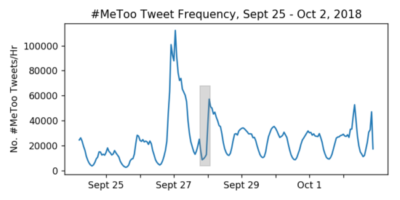
There was a huge spike of #MeToo tweets Sept 27.
The grey bar indicates missing data from Sept 28.
What tweets exactly are being counted? Over Sept 15-27 I curated a list of hashtags to track, aiming to capture #MeToo spirit without taking unnecessary Kavanaugh crossfire. During that time, #BelieveSurvivors grew from zero to the number one trending hashtag on Twitter of Sept 24. My final list of 20 “#MeToo hashtags” also includes #WhyIDidntReport, #BelieveWomen, #MenToo, #MeTooMvmt, #SurvivorCulture, and #HimToo. Below is a word cloud showing all the top hashtags from the 5 million tweets charted above.
All these maps and charts are a nice start, but how can we better understand what’s happening on the two sides of this “conversation”? One way is to make separate word clouds, one for each side:
We can see some important differences based on these word clouds, like #HimToo on the right and #WhyIDidntReport on the left. But the differences are obscured by the overwhelming similarities. For example, barely a day after #BelieveSurvivors exploded on the left, it became just as huge on the right, and so both word clouds feature this hashtag prominently, which does not help us understand the differences between left and right.
Let’s look at this problem another way. We’ve got 5 million Tweets from 1.5 million users. Based on network clusters, we can categorize many (maybe most) of those users as “left” or “right.” What happens if we make one bucket of tweets from known “left” users, another bucket of tweets from known “right” users, and then teach a computer program to recognize the difference between a “left” tweet and a “right” tweet? If we succeed, then we can use that computer program to score any #MeToo tweet on left-vs-right partisanship, including tweets from unknown users and without even drawing a network map.
We have formulated a classic problem of machine learning. Skipping some technical detail, we train a classifier to recognize our two categories of #MeToo tweets with roughly 87% accuracy. Not bad. If we crack open the resulting classifier, we find model coefficients that tell us exactly which words are most strongly associated with each side of the #MeToo divide. The bigger the bar, the more influence it has on our “prediction”:

The words listed above do not have any extraneous hashtags that are popular on both sides. We are looking at the most significant single-word indicators that a tweet is either “left” or “right.” The top two and bottom two make perfect sense. The left champions #SurvivorCulture and #StopKavanaugh. The right champions #HimToo (a cry to protect men from false accusations) and #ConfirmKavanaughNow. Some words included in the list are not obviously partisan (#world) and we’d want to do more model-training if we were really serious about classifying lots of future tweets very accurately.
Let’s run with our first-draft model for now. With it, we can actually compute, for any #MeToo tweet, the probability that it’s left or right. If a tweet scores 0.0001, then it’s almost certainly left, and it it scores 0.9999 then it’s almost certainly right. If we can score tweets this way, then we can aggregate tweet scores user by user and estimate how far each individual leans left or right (on a zero-to-one scale), based on what they’re literally saying and without having to bother with a map. Below we see a curve of tweet scores based on Sept 25-27.
The rainbow in the chart above shows how we assign a color to each score value from zero to one. This will be handy when we start assigning scores to nodes and edges in network maps.
Based on the distribution above, let’s consider a more nuanced classification than the binary “left” vs “right.” I’ve proposed four categories, and selected 2-3 of the most-retweeted examples within each category. It looks good at the far ends, with a miss or two in the mid-left and mid-right.
[ap_spacing spacing_height="15px"]
Far Left: ~500K tweets scoring 0.0-0.15:
"i was raped at Yale. i was groped at parties in dke’s house—#kavanaugh’s fraternity at yale—and was told as a freshman to avoid their “rape basement.” multiple dear friends were raped by yale dke brothers & by boys from elite prep schools. i believe ramirez. #believesurvivors"
"by scheduling a vote on judge kavanaugh before dr. ford has even testified, senate republican leaders are saying loud and clear: they don’t care what she says. #believesurvivors"
"mr. president, enough. a supreme court nomination is not worth more than the lives of survivors. there must be a full investigation of these allegations of criminal behavior, and judge kavanaugh’s nomination must be withdrawn."
[ap_spacing spacing_height="15px"]
Mid Left: ~300K tweets scoring 0.15-0.35
"ladies, a question for you: “what would you do if all men had a 9pm curfew?” dudes: read the replies and pay attention. #metoo #kavanaugh #cosby #feminism #maleprivilege #privilege"
"tune in as democrats show our support for dr. christine blasey ford. #believesurvivors"
"so, the same party that wants to force teenage boys and girls to shower together in the name of transgender rights is also leading #metoo against sexual predators?"
[ap_spacing spacing_height="15px"]
Mid-Right: ~200K tweets scoring 0.35-0.75
"modern feminism has never been about equality with men.
it has always been about special treatment and exemption from all responsibility. many condemned me for being one of the first to speaking out against #metoo. now it’s toxicity is on full display. #defendourboys"
"you can like or not like @michaelavenatti but what he just put out is a sworn affidavit alleging that kavanaugh and mark judge regularly gang raped women including once his client julie swetnick. i believe survivors."
"it’s all about #metoo & #webelievesurvivors unless the survivors support @realdonaldtrump or the sexual predator is a democrat. ain’t that right @keithellison @maziehirono @senfeinstein & @billclinton @dnc the party of hypocrisy
[ap_spacing spacing_height="15px"]
Far Right: 100K tweets scoring 0.75-1.0
"i’m loving the hashtag #himtoo. it appears to be a movement built of men who have had their lives and families destroyed by false allegations and a lack of due process. radical feminism has become problematic and needs to be addressed. dr. luke, brett kavanaugh… #himtoo"
"serious question. are keith ellison, sen. sherrod brown, sen. booker and sen. tom carper signing on? i know they’re democrats but thought it’s only fair to ask given their history’s on this subject."
[ap_spacing spacing_height="25px"]
COMING SOON…
With a good scoring and coloring system, along the lines described above, we can apply those colors to every node and edge of a twitter map, and see “exactly” where left- and right-leaning discussions are happening, along with some shades in between the extremes. Something like this:
Prototype #MeToo Twitter network map,
With color spectrum to indicate extent of left vs right expression.
Let me know what you think. I am especially interested in movement organizer folks who have suggestions for improving the relevance and usefulness of this method to provide them with actionable information.
Originally published 10/9/18 at Connective Associates.
Network Trust Assessment
Trust In Networks
Trust in networks is different than trust in organizations or coalitions where it is essential to spend time building trust among everyone because the relationships are likely to be long-term.
However, networks often have hundreds or even thousands of participants and it is not possible for everyone to know everyone else in the network, let alone have the time to build deep relationships. People in self-organizing networks are often involved in a number of collaborative projects at any one time, but these projects are often of short duration with little time to build deep trust, and after the end of the project they may not work with those individuals again.
For this reason, people in networks need to learn how to build swift trust. Swift trust, explored by Debra Meyerson and colleagues, means that the participants of a collaborative project interact as if trust were present.
Several things make establishing swift trust easier. First, when a few of the collaborators have had previous experience working together, they can set the tone or standard of trustworthiness that others buy into. For example, they can model openness, appreciation and other qualities that help everyone be more trustworthy.
Another key to swift trust is the communications ecosystem and values. By agreeing to be transparent and make all their work easy to observe and be accessed by others, it’s easy for all participants to see that others are doing the work they said they would do. That’s why it’s so important to use tools like google docs and set up task and timeline spreadsheets, a place for meeting notes and a budget and expense spreadsheet. Slack is another tool that helps people see what others are doing.
Another essential ingredient of swift trust is taking time to clarify roles in the project based on specific expertise. For example, I am in a collaborative project where one person is responsible for developing content, another for the tech aspects of the virtual sessions, and other for the communications. This doesn’t mean that each person does all the work in their area - in fact, we often work together on content - but one person is responsible for moving that part forward. The clearer the roles are to everyone, the less conflict is likely to occur.
As in any situation, it’s always important to take time to help people know each other: even if the group is working virtually, it’s easy to set up breakout rooms in zoom.us where smaller groups or dyads can share about themselves. If the project has a convener, it’s helpful for them to state values such as “We are all unique, and each of us has quirks or things about ourselves that can affect our work. For example, one person has a child with a chronic illness; another person may be very introverted. We need to get to know people so that we know about these things and realize the parent may be called away from work to care for the child and we need to make sure the introverted person has space to talk.”
Having skills in dealing with a person when they do not do what they have agreed to do is essential. People quickly become more reliable if small infractions are dealt with immediately and directly (often through a one on one conversation).
If someone proves to be difficult to work with or untrustworthy, they will find that they are not included in future network collaborations. This is a powerful incentive for most people to contribute as positively as they can. Word of mouth that occurs in the network means that effective contributors will find they are frequently sought after for projects.
Undergirding swift trust is a set of network values and understandings - things such as openness, transparency, acceptance of difference. Network weavers can help ensure that most network participants are aware of these values.
On Friday we will offer a free Trust Assessment that network weavers can use to increase network participants awareness of these critical elements of trust. [ap_spacing spacing_height="30px"]
How To Increase Participation Through Increased Engagement
[ap_spacing spacing_height="15px"]
A new free resource is available in the Resources section of Network Weaver.
 Many people ask me "How do I get people to participate more in our network?" This simple worksheet offers tips that you can quickly implement to get network participants interacting with each other. We have found that is one of the best strategies for getting them to invest more time in the network.[ap_spacing spacing_height="25px"]
Many people ask me "How do I get people to participate more in our network?" This simple worksheet offers tips that you can quickly implement to get network participants interacting with each other. We have found that is one of the best strategies for getting them to invest more time in the network.[ap_spacing spacing_height="25px"]Appreciative Reflections
I have a number of ‘network friends’ – people I know, online & by video & phone, whom I’ve not yet met in the flesh. People who for one reason or another, reached out to me, or I reached out to them, knowing by our online presence & by our shared connections to others that we had something to learn together.
In this growing field of ‘Network Weaving’, it’s easy to connect quickly & begin to share work, ideas, resources and to bond in a real way, with people we’d normally consider strangers.
One of the women I’ve connected to in this way just shared something with me that she’s been working on. A beautiful contribution to our field that she’s been toiling away on so long she’s lost track, a little bit, of the value & beauty in it. As I affirmed & appreciated her efforts via email, she reflected me back to myself in a way I aspire to, but, honestly, I DO NOT know what causes her to see me in that way. She sees the me I’d like to be, but don’t identify as self.
As I began to write a reply email, saying that I’m honored by how she sees me, even tho I cannot see myself the way she does, this struck me:
[ap_spacing spacing_height="15px"]
When we connect & share & trust & honor, we begin to see the strengths, beauty, & potential in one another that we can’t entirely see in ourselves. And when we voice those things we see in one another, we help bring them into being even more.
[ap_spacing spacing_height="15px"]
Her words made me feel SEEN, recognized. Which inspires and en-courages me to be more of what she saw, even if I’m not entirely sure what allowed her to see it.
No doubt this seems elementary to good parents & teachers (I mean, as a parent, that power to bring out the best in my son by simply reflecting him back to himself was awe-inspiring) – but there was a new epiphany in it, for me, today.
So – here’s the part that was striking in the moment – what we see in each other, and call out in one another – becomes the very source of transformation. A greater belief in our gifts increases our ability, willingness & desire to give of them. Seeing one another’s gifts brings about more of those gifts. Feeling valued and recognized also increases our willingness to collaborate, our openness to others, our ability to journey together into the unknown.
System change & saving the world are hard work that many people want to be part of. But over and over, we hear how people are just below their breaking points, stretched to their limits, overwhelmed with how much effort it takes just to maintain. They can’t take on even one more small commitment. But when the efforts that align with our passions or express our deepest selves are met with affirmation & encouragement, what we do becomes a little less effortful, we regain energy faster, we contribute again sooner and more. Recognizing & affirming each other, in a change network, can be one of those small shifts that bring about huge changes.
As a traumatized hyper-vigilant welfare brat, I’ve usually been highly suspicious of compliments or kind words, and have spent much of my life pushing them away.
But lately I’ve been learning, in very tangible ways, how our piling on sincere appreciation & authentic recognition of one another not only heals & encourages at the individual level, it fuels collective transformational ripple effects.
[ap_spacing spacing_height="20px"]For Mary Roscoe for inspiring this reflection and for Michael Bischoff, for seeing the true me into being.
[ap_spacing spacing_height="20px"]Originally published May 16th, 2016 by Christine Capra at GreaterThanTheSum.com
